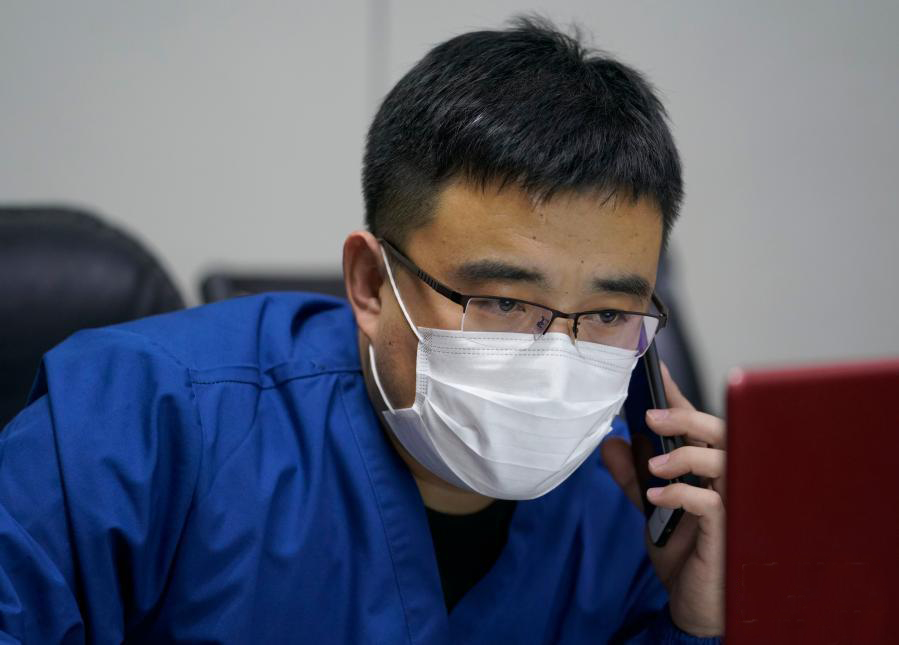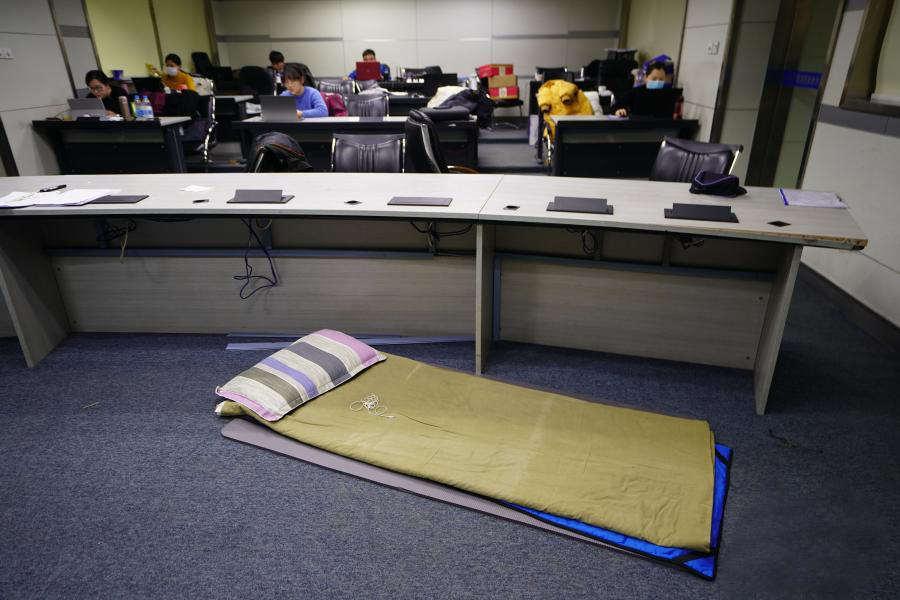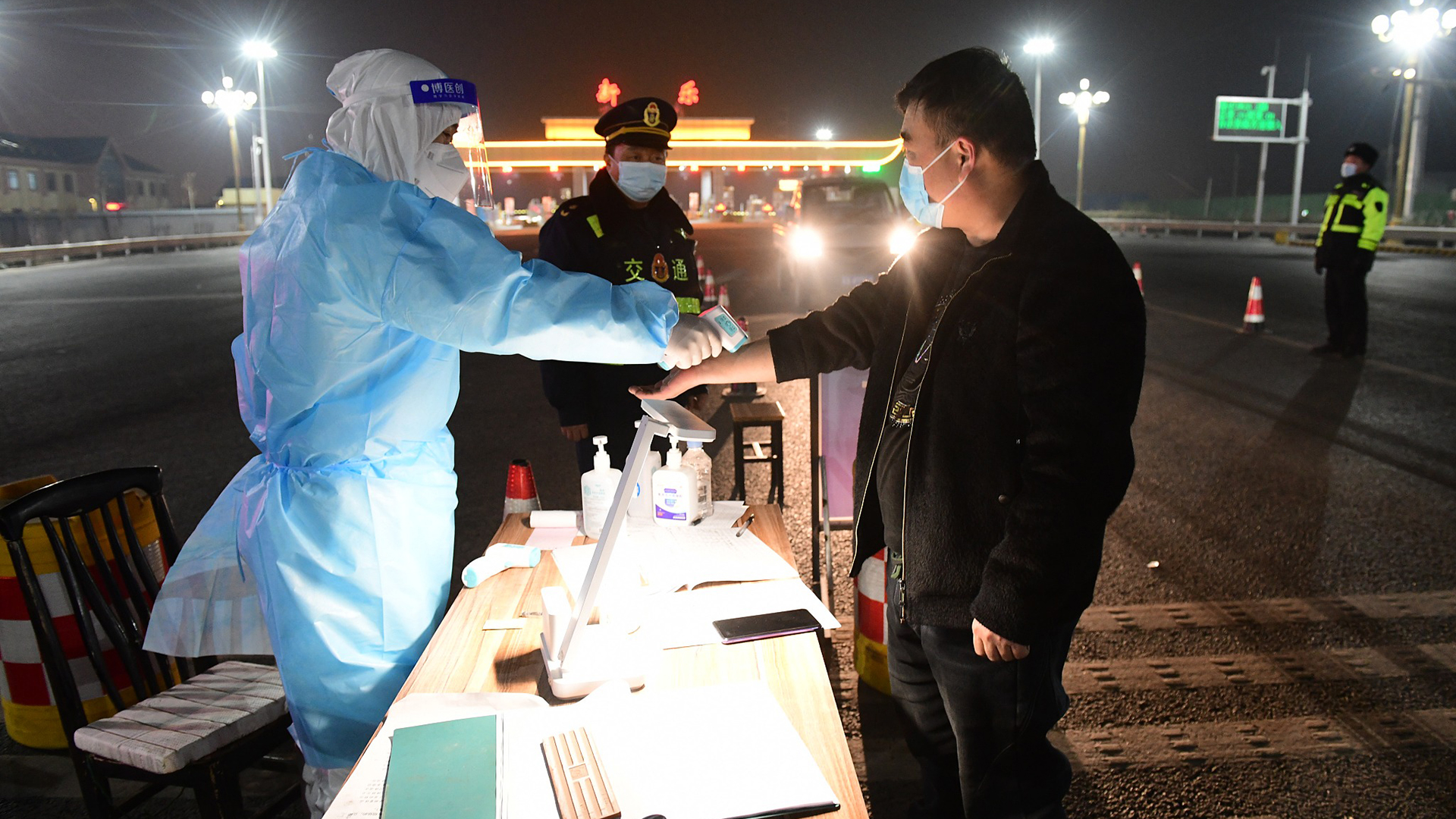
A worker is seen in the office of the Center for Disease Control and Prevention in Shijiazhuang City, north China's Hebei Province, January 13, 2021. /Xinhua
A worker is seen in the office of the Center for Disease Control and Prevention in Shijiazhuang City, north China's Hebei Province, January 13, 2021. /Xinhua
"There was a village fair several days ago. Did you go there?"
"After you went back, where else did you go? Can you remember?"
"After you met with X (a confirmed case), did you meet any other people?"
At the Center for Disease Control and Prevention (CDC) in Shijiazhuang, the capital of north China's Hebei Province, a group of workers call the close contacts of confirmed COVID-19 cases and quickly jot down what they hear.
Empty meal boxes, instant noodle plastic bags, wrinkled bedding are scattered on the floor. The investigators are busy, racing against time to stop the spread of the coronavirus in Shijiazhuang.
After months of zero cases, Shijiazhuang reported its first locally transmitted case on January 2. By January 10, the number of daily reported new cases surged to a record 82.
Five days earlier, the city had entered lockdown mode, with local officials launching citywide nucleic acid testing for all residents on January 6.

A pillow and a mattress on the floor of an office at the Shijiazhuang Center for Disease Control and Prevention in Shijiazhuang City, north China's Hebei Province, January 13, 2021. /Xinhua
A pillow and a mattress on the floor of an office at the Shijiazhuang Center for Disease Control and Prevention in Shijiazhuang City, north China's Hebei Province, January 13, 2021. /Xinhua
A race against time
"Since the outbreak of the epidemic, over 300 field investigators have been deployed to work in rural areas and designated facilities," said Guo Jianhua, deputy director of the Shijiazhuang CDC's epidemiological bureau. "To save time, most of our workers eat and sleep in the office. It can be said we're racing against time with the virus."
Guo explained that when outbreaks of disease occur, field investigators are urgently needed to identify the source or cause of the problem as a basis for control. Chinese investigators also have to track every suspected COVID-19 case and find out where they have been and who they've come into contact with so that medical workers can quickly take steps to address the situation, for example, quarantines, to stop the spread of the epidemic.
When they do field investigation, they must wear full protective suits, N95 medical protective masks, goggles and latex gloves. Even in the winter season, after working for many hours, they often soak through.
In Shijiazhuang, about 80 percent of the positive cases are in rural villages, which has intensified the difficulty of investigators' work.
"Some villagers don't know the importance of (tracing), so they don't support our work," said Zhou Jikun, deputy director of the Shijiazhuang CDC.
"Sometimes, villagers don't remember where they went, so we have to guide him/her step by step and then check the information with his/her family members and friends," Zhou added.
02:35

Labor-intensive work
The work of field investigators also involves environmental sample collecting and disinfection.
Li Jiesheng, a 48-year-old field investigator from central China's Hunan Province, is in Shijiazhuang. His work entails collecting environmental samples at locations where COVID-19 cases are detected and overseeing the disinfection of quarantine facilities and/or homes.
"The local officials work to treat confirmed cases. Our job is to reduce the chances of the virus spreading in order to stop case numbers from rising," Li told CGTN.
Despite wearing full protective gear, Li sometimes needs to carry a 25-kilogram bucket full of disinfectant for up to four to five hours, with no time to go to the bathroom or take lunch.
"When the National Health Commission asked us to help out in Shijiazhuang, we knew it was a call of duty," Li said. "We knew we must come here. It was within our line of expertise. There were no hesitations at all."
He had been on the front line in Wuhan at the height of the outbreak last year, and the Huanan Seafood Market, the first place where the coronavirus was found, was one of his battlefields. For him, there is no difference between his work in Wuhan and Shijiazhuang.
On Friday, Shijiazhuang reported 19 confirmed cases, which experts believe will soon be contained. With the decreasing number of COVID-19 cases, the field investigation team, which consists of many medical experts from different provinces, has shifted its focus from working on the hotspots to training local health workers.
"Our goal is to leave the city with a capable team of their own," Luo Kaiwei, captain of the Shijiazhuang Pandemic Investigation Team from Hunan, told CGTN.
From January 6 to 22, Shijiazhuang carried out three rounds of full-staff nucleic acid tests, testing a total of more than 30 million people.
Zhang Boli, president of Tianjin University of Traditional Chinese Medicine and the honorary president of China Academy of Chinese Medical Sciences, went to Shijiazhuang to instruct local health workers on January 15.
On Monday, Zhang said the epidemic in Shijiazhuang was under control. However, the city still has to be very careful in January and February so that the coronavirus can be completed contained in March.

